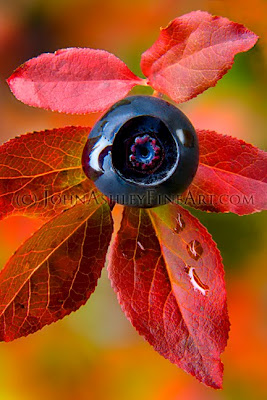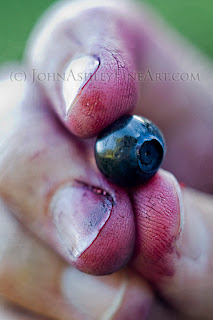A cold front blows hurricane-force winds across more than 2,000 small wildfires that had been quietly burning in the drought-stricken northern Rockies. Wind whips the small fires into one or two massive infernos that levels a handful of towns and 3,000,000 acres of mostly inaccessible forest -- with most of the burn occurring in just six hours. Two days later, the fire is extinguished by a second cold front that brings steady rain.
Eight towns burned to the ground, and 87 people perished. Many survivors left for good, while some returned to rebuild. Parts of 10 national forests were turned to ash. And the five-year-old "National Forest Service" began its policy of fighting every fire.
 |
| Late-summer huckleberry |
BEARS, INDIANS, AND EARLY WHITE SETTLERS
Bears depend on these high-energy fruits (huckleberries make up about 1/3 of their fall diets) to add enough fat to survive the rigors of winter hibernation. And for centuries, wild huckleberries have been a staple food for all of the native tribes between the Pacific coast and western Montana. Early Indians made combs out of salmon backbones and used them to help strip berries from bushes. The berries are then dried and stored like raisins, or mashed into cakes. Early white settlers learned about huckleberries from local Indians, and soon they too were counting on the berries.
In 1615, white settlers in New England first reported native Algonquins collecting and drying huckleberries. Travelling through Pennsylvania in 1743, naturalist John Bartram reported on how the locals dried their huckleberries over a smoky fire. In August of 1805, Capt. Merriwether Lewis reported on his breakfast with huckleberries. And at the time of his death, in 1862, Henry David Thoreau was working on an extensive history of huckleberry picking in the northeast.
In the northwest, native tribes have long understood the connection between fire and huckleberries. Unless maintained by periodic burning, the huckleberry patches slowly shrink as trees advance into the clearings. As one Yakima leader explained, "God told people to burn the forests and the huckleberries would grow." The ashes also stimulate the native grasses, which helped Indians feed their horses.
 |
| Huckleberry flowers |
The Great Fire of 1910 slowed huckleberry production for a few years. But by the 1920's, it had actually produced thousands of new huckleberry acres in northern Idaho and western Montana. At the same time, the renamed "U.S. Forest Service" made fire prevention its new priority, followed closely by road construction for fire fighting access -- access right into lots of that new huckleberry habitat.
Between 1900-1920, "berry picking vacations" were common for people living in Montana. These trips might last a day or a month. But collecting was limited as most families only picked enough huckleberries for their own needs. Picking and preserving too many berries was hard work.
NEW TECHNOLOGIES OF THE 1920's AND 1930's
"Canning" technologies -- invented by Napoleon to feed his armies, and advanced during the U.S. Civil War -- became popular in the 1920's as families started putting up their home-grown fruits and vegetables. The availability of commercially prepared foods was still a couple of decades off.
Commercial fruit production in Montana of the 1920's was limited to Swan Valley strawberries, Bitterroot Valley apples, and Flathead Valley cherries. Wild huckleberries were different from these domestic crops. They were much more labor intensive, they ripened during a relatively short period of time, and berry production was unreliable and varied greatly from year to year. But the berries were free, and technology would help them become a commodity.
BOOM & BUST -- THE GREAT DEPRESSION AND WORLD WAR II
When the stock market collapsed in October, 1929, it crushed the farming, mining and timber industries that had supported many Montanans. The Great Depression quickly spread world-wide, and jobs were hard to come by during the 1930's. But money earned from the huckleberry season saved many Montanans who couldn't find fulltime work. A number of eastern Montana farmers who went under became western Montana huckleberry pickers. Huckleberry culture was booming in spite of the Depression.
 |
| Purple fingers |
In 1932, there were 20,000 gallons of wild huckleberries collected on the Flathead National Forest. That same year, more than 50,000 gallons were commercially harvested on just one district of the Cabinet Nat. Forest. At the going rate of 40 cents per gallon, a conservative estimate of 60,000 gallons on the Cabinet gives a huckleberry crop worth $24,000 (in 1932 dollars). Regional forester R.F. Hammatt pondered if, "...our policy of land management should lay stress on the growing of timber or if huckleberries may be the more profitable crop."
Berry pickers flooded Forest Service campgrounds during the season. On the Kootenai Nat. Forest, commercial camps were set up that accommodated more than 400 people on 11 acres. An enclosed strip down the middle segregated white picker tents from hundreds of Indian tipis, but social interactions were still common. This berry boom lasted a dozen years or so, until the U.S. entered World War II.
The Second World War, between 1939 and 1945, prompted the revival of U.S. "Victory Gardens." Almost three-quarters of American families were canning their own food in 1944. But all this canning by amateurs led to many cases of food poisoning, exploding jars and ruined stoves. By the time the war finally ended, canning had earned a bad reputation. Home canning declined as store-bought frozen foods became more widely available after the war.
BUST & BOOM -- THE POST-WAR ECONOMY
 |
| Huckleberry pie meets vanilla ice cream |
In 1949, the oldest Montana huckleberry business that is still in operation, Eva Gates Homemade Preserves, started quietly with just a few batches cooked up in Grandma Eva's garage. The family business had little competition until the late 1970s.
Montana's population growth began booming in the 1970s, and berry picking slowly became financially viable once again. The Baby Boomers were no longer canning, but they remembered picking and canning from their youth, and so nostalgia was used to market Montana huckleberries to them. Next up, Generation-X had no prior history with huckleberries, so newer products were also marketed as something novel and "wild and pure." A Missoula manufacturer sold 1,600 huckleberry gift boxes in three minutes on the QVC Channel, mostly to Generation-Xers on the east coast who had never even heard of huckleberries.
Nowadays there are more than 100 different huckleberry products, as varied as huckleberry soap and huckleberry beer. In 1996 there were 59,000 pounds of huckleberries processed by Montana manufacturers. Most of the berries (85%) were from northwestern Montana, while the rest came from northern Idaho. Jams, jellies and preserves accounted for 54% of that year's sales of $1,557,503. Seven years later, huckleberry sales had declined somewhat, to just over one million dollars.
Currently, the huckleberry themselves are also in a slow decline. A 6,000 acre huckleberry field set aside in 1932 for Native American use has shrunk by one-third. For the current generation of Montanans, the large berry fields of yesteryear are more likely to be small patches hidden in a thickening forest.
Recent research has shown that undisturbed forests contain the least productive huckleberry patches. The most productive patches are on northern or eastern faces that were either clearcut and burned 8-15 years earlier, or burned over by wildfire 25-60 years ago.
Behind the berry: Some of the juicy information for this article was hand-picked from the 2006 Forest Service publication, "A Social History of Wild Huckleberry Harvesting in the Pacific Northwest." It includes lots of great, historical photographs, and it's a fascinating read for anyone who has ever picked a wild Montana huckleberry.
Looking for a Montana cultural experience? Major huckleberry product manufacturers include:
Eva Gates Homemade Preserves, Bigfork (406) 837-4356
Huckleberry Patch, Hungry Horse (406) 387-5670
The Huckleberry People, Missoula (406) 721-6024
Doug Allard's Trading Post, St. Ignatius (406) 745-2951
Larchwood Farms, Trout Creek (406) 827-4943
.


